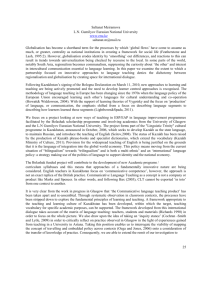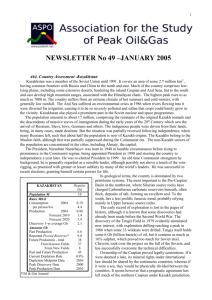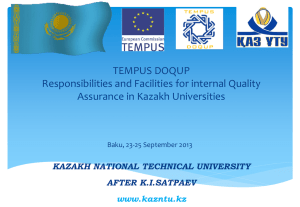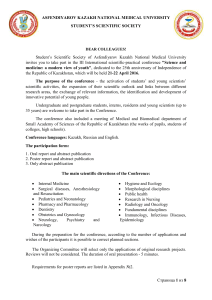Kazakh Informational Report
advertisement
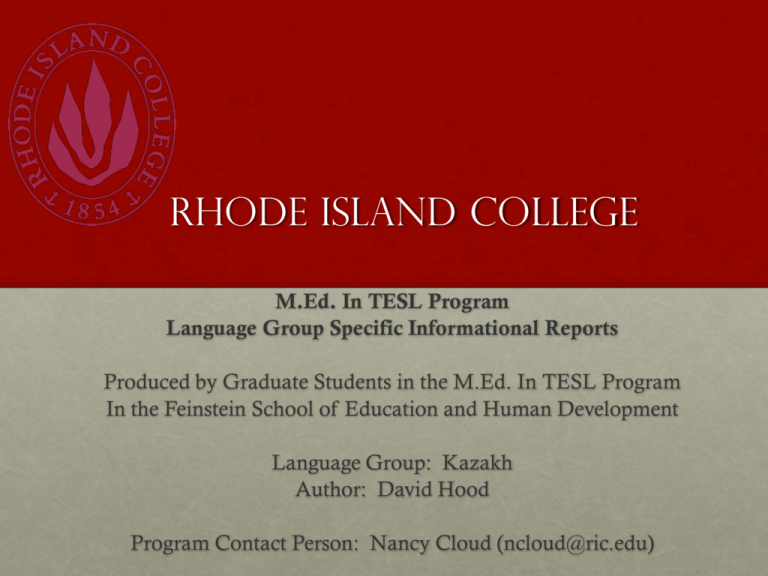
Rhode Island College M.Ed. In TESL Program Language Group Specific Informational Reports Produced by Graduate Students in the M.Ed. In TESL Program In the Feinstein School of Education and Human Development Language Group: Kazakh Author: David Hood Program Contact Person: Nancy Cloud (ncloud@ric.edu) Kazakh Informational Report David Hood TESL 539 Spring 2011 Where is it spoken? Kazakhstan, China, Mongolia, Afghanistan, Tajikistan, Turkey, Turkmenistan, Ukraine, Uzbekistan, Russia, Iran, Germany 15 million people world wide (UCLA Language Materials Project, n.d.) 66th in number of speakers worldwide (UCLA Language Materials Project, n.d.) Facts about the language -State language of the Republic of Kazakhstan (Official Language: Russian) (Kwint Essential, n.d.) -40% of Kazakhstan's total population are ethnic Kazakhs, 38% are Russian, the rest are a mixture of predominately Slavs or Germans (UCLA Language Materials Project, n.d.) -Most widely spoken Turkic language in Central Asia (UCLA Language Materials Project, n.d.) -Primary and secondary students in Kazakhstan are taught in Russian with Kazakh taught simultaneously (UCLA Language Materials Project, n.d.) -Considered to be a common language amongst Muslims (UCLA Language Materials Project, n.d.) A common misconception of the language… Many people believe it is the same or very similar to Russian. Russian is an Indo-European language (Most major European languages and dialects) (Kazakhstan Discovery, n.d.) Kazakh is an Altaic language (Turkic, Mongolic, Tungusic language family) (Kazakhstan Discovery, n.d.) Do Russians speak Kazakh? Yes, but sparingly (560,000 speakers were reported in 2002 in a Russian Census) Language Variations 3 major dialects in Kazakhstan (UCLA Language Materials Project, n.d.) Northeastern Kazakh Southern Kazakh Western Kazakh No major differences other than accent Many other Turkic languages are sometimes perceived as having Kazakh language roots. (UCLA Language Materials Project, n.d.) Writing System/Orthography: Written using Arabic script till 1929 (UCLA Language Materials Project, n.d.) Used the Roman alphabet (Latin) from 1929-1940 (UCLA Language Materials Project, n.d.) Currently use Cyrillic (UCLA Language Materials Project, n.d.) Cyrillic Latin Arabic Barlıq adamdar بارلىق ادامدار تۋمىسىنان twmısınan azat jäne All human beings قاسيەتى مەن- ازات جانە قادىرqadir-qasïyeti men are born free and كۇقىقتارى تەڭ بولىپ دۇنيەگەquqıqtarı teñ bolıp equal in dignity and - ادامدارعا اقىل.كەلەدى dünïyege keledi. rights. They are وجدان- ار،پاراسات Adamdarğa aqılendowed with سوندىقتان والر، بەرىلگەنparasat, ar-ojdan reason and ،بىرىمەن تۋىستىق-ءبىر berilgen, sondıqtan conscience and قاتىناس-باۋىرمالدىق قارىم olar bir-birimen should act towards جاساۋالرى ءتيىس. twıstıq, bawırmaldıq one another in a qarım-qatınas spirit of jasawları tïis. brotherhood. English Барлық адамдар тумысынан азат және қадір-қасиеті мен кұқықтары тең болып дүниеге келеді. Адамдарға ақыл-парасат, арождан берілген, сондықтан олар бір-бірімен туыстық, бауырмалдық қарым-қатынас жасаулары тиіс. Orthography cont. Cyrillic Alphabet -42 letters (Vestnik, 2005) -9 vowels (Vestnik, 2005) -Can be short or long sounds- similar to English -Kazakh uses vowel harmony and it is common to see vowels next to each other in words (Vestnik, 2005) -Stress is typically found at the end of a word (Vestnik, 2005) http://www.baylor.edu/content/imglib/52880.jpg Common Errors in Phonology Stress in the English language varies, where Kazakh is almost always at the end of the word. (About World Languages, 2011) Kazakh learners trying to learn English will typically have difficulty in mastering English intonation and rhythm. (About World Languages, 2011) Kazakh learners will cluster consonants together initially-since their language is ruleless when it comes to vowel and consonant order. (About World Languages, 2011) When speaking English the learner will sometimes insert vowels after the 1st consonant. (About World Languages, 2011) Errors in Grammar Kazakh and English convey meaning differently through verb systems. (Vestnik, 2005) Tenses used in Kazakh are similar to the structure of the Russian language, where it is based on the concept of aspect: Actions are either completed or not completed Causing the language to use few auxiliary verbs. Where English has progressive and perfect tense forms, avoiding the need for affixation of an auxiliary verb. - (Vestnik, 2005) Common problems that are associated with this issue… Learners will not include an auxiliary verb. Example: I no want it./ I not big enough. Grammar errors cont. : In the Kazakh language there are no articles. (Vestnik, 2005) Teaching articles to a Kazakh learner will be abnormally confusing since it will be a new concept for the learner. The English article system is very complex and to a Kazakh learner who only knows three genders there will be cause for much confusion. Example: Have you seen my new car? / Yes, she is very nice looking! Other common errors: Most words in the Kazakh language are spelled phonetically. Meaning most pronunciation can be predicted from the spelling of the word. (Vestnik, 2005) Although some English words can be pronounced phonetically, higher level vocabulary cannot and will cause an issue for learners. Many translations of Kazakh to English will sound abrupt and rude. For example: Would you like to study with me? / No, I wouldn’t. Do you know how to cook? / Yes, of course. Learners will need to learn qualifiers to overcome the difference from the abrupt style of Kazakh Communication Norms Kazakhs typically use different tones to be as diplomatic as possible with certain groups (family, friends, employers, etc.) (Vestnik, 2005) They normally speak in a gentle tone, which sometimes causes them to speak in circles instead of a linear English style. (Vestnik, 2005) They respond to gentle probing rather than direct questioning (Vestnik, 2005) At the same time, many Kazakhs are known to be very argumentative. Hierarchy is respected in Kazakhstan. Elders and those with authority should never be disrespected or corrected. (Vestnik, 2005) Since there is a large variety of ethnic groups in Kazakhstan it is impolite to ask about one’s ethnicity (Intercultures, n.d.) It’s customary to keep an arms length distance away from a speaker (Intercultures, n.d.) Sources Internet Sites Becthhk Kacy. (2012). Teaching English phonology in the counrty of Kazakhstan: A preliminary evaluation. Retrieved March 7, 2011, from: http://www.vestnik-kafu.info/journal/2/39/ Centre for Intercultural Learning. (2009). Cultural Information: Kazakhstan. Retrieved March 27, 2011, from: http://www.intercultures.ca/cil-cai/ci-ic-eng.asp?iso=kz#cn-1 Kazakhstan Discovery. (2012). Kazakhstan language facts. Kazakhstan Discovery. Retrieved March 5, 2011, from: http://www.kazakhstandiscovery.com/kazakhstan-language.html Kwintessential. (n.d). Kazakhstan: Language, culture, customs and etiquette. Kwintessential. Retrieved March 5, 2011, from: http://www.kwintessential.co.uk/resources/globaletiquette/kazakhstan.html The Technology Development Group. (2008). Kazakh. About world languages. Retrieved March 5, 2011, from: http://www.aboutworldlanguages.com/Kazakh/#intro UCLA International Institute. (n.d.) Kazakh. UCLA language materials project: Teaching resources for less commonly taught languages. Retrieved March 5, 2011, from: http://www.lmp.ucla.edu/profile.aspx?langid=60&menu=004 Images Baylor University. (n.d). Cyrillic Alphabet [Image], Retrieved March 19, 2011, from: http://www.baylor.edu/content/imglib/52880.jpg UCLA Language Materials Project. (n.d.). Kazakh [Map], Retrieved March 5, 2011, from: http://www.lmp.ucla.edu/profile.aspx?langid=60&menu=004 M.Ed. in TESL Program Nancy Cloud, Director Educational Studies Department Rhode Island College, HBS 206 #5 600 Mt. Pleasant Avenue Providence, RI 02908 Phone (401) 456-8789 Fax (401) 456-8284 ncloud@ric.edu The M.Ed. in TESL Program at Rhode Island College is Nationally Recognized by TESOL and NCATE

